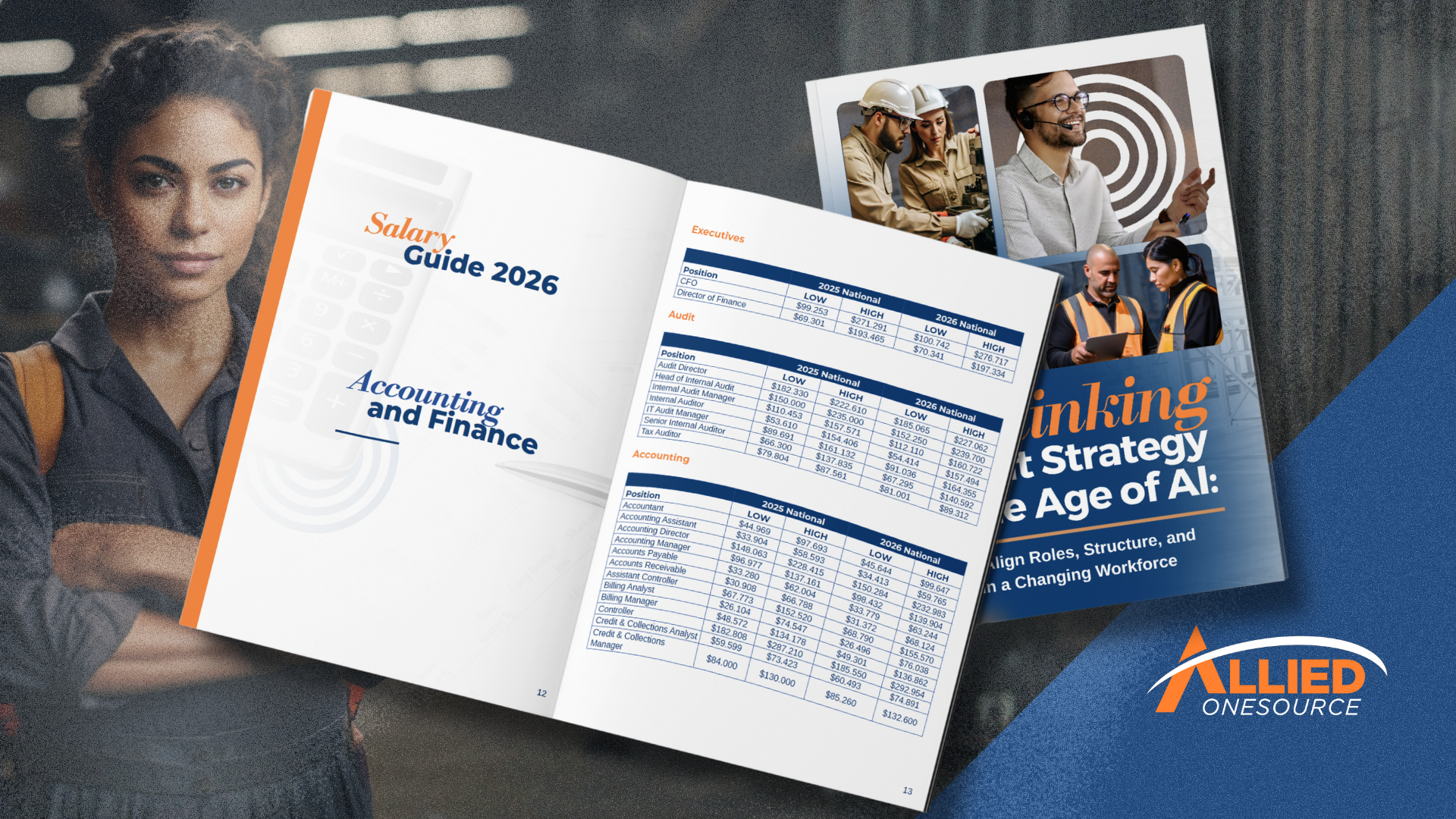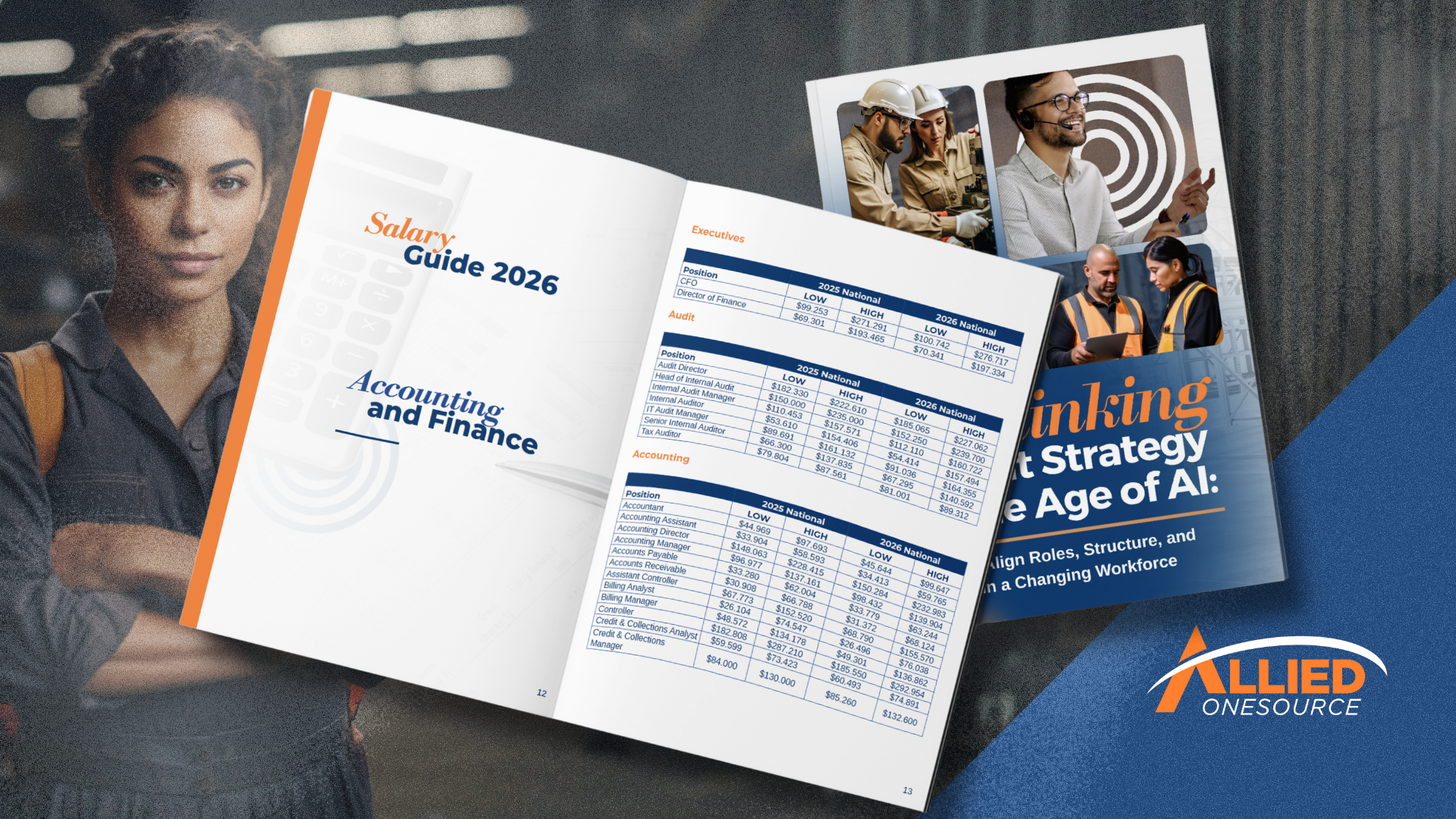Bridging the Skilled Trades Gap: How to Attract Experienced Machinists, Welders, and Electricians
The skilled trades worker shortage is getting worse. Companies are losing bids, delaying projects, and overworking existing teams because they struggle to find qualified personnel. Over a million trade jobs remain unfilled across the industry.
The scale keeps growing: approximately 450,000 workers leave the trades permanently each year, necessitating replacements. By 2030, manufacturing alone will face 2.1 million unfilled jobs,¹ while construction jobs are expected to grow faster than average through 2033, meaning more than 660,000 skilled positions need filling every year.²
As a staffing partner working directly with trades companies, Allied OneSource sees this crisis daily, and we know what works to fix it.
Why the Skilled Tradesperson Shortage Exists
The tradesperson shortage isn’t caused by one issue. It’s the result of compounding challenges that have been built over time. Here are the main drivers impacting your hiring pipeline:
1. Retirements Are Outpacing Replacements
Nearly half of today’s skilled trades workers are over 45³. As they retire, fewer young tradespersons are stepping in to replace them. This growing gap causes project delays, safety risks, and rising costs. Employers without a workforce plan in place will feel the strain more in the next 5 to 10 years.
2. Declining Interest from Younger Generations
Trade careers are often overlooked in favor of four-year degrees. Many students are pushed toward college by parents, teachers, and schools that still see it as the “better” path. As a result, trades are viewed as second-tier or fallback options. But skilled trades offer strong pay, job stability, and room to grow.
Without clear exposure to these benefits, students miss out, and businesses lose a steady pipeline of entry-level talent. That growing gap slows operations, adds pressure on current teams, and limits how fast you can scale or take on new projects.
3. Outdated Training Pipelines
Many high schools have cut vocational programs. As a result, fewer students get the hands-on experience needed for skilled trades. This leaves new hires unprepared. Employers must invest time and resources in basic training. The longer it takes to get workers ready, the longer critical roles stay open. This puts more strain on your existing team to keep projects moving.
4. Rising Demand Across Industries
Tradespersons aren’t just needed in construction and manufacturing. Clean energy, transportation, and infrastructure are also expanding, driving up demand for electricians, welders, machinists, and other hands-on specialists.
With more sectors competing for the same talent, it becomes harder to attract and keep qualified talent. That leads to longer hiring cycles, higher labor costs, and a greater risk of project delays.
What Attracts and Retains Skilled Trades Talent
To close the labor gaps, employers must attract and retain the right talent. That means having a clear plan that limits turnover, strengthens teams, and keeps work on track.
Here’s how to build the kind of environment qualified trades talent want to join and grow in:
1. Build a Reputation Tradespeople Trust
Tradespersons seek more than just pay. They want a workplace that values safety, respects its people, and supports long-term growth. If your company delivers these, make it visible. Use your website, job ads, and social media to show what working with you looks like.
Highlight real examples—long-term employees, safety programs, or stories of apprentices rising into leadership. This builds trust and shows candidates that your company offers a career, not just a job.
2. Offer Competitive Compensation and Perks
About 90 percent of tradespersons report high job satisfaction, but only when pay and benefits meet expectations.⁴ Falling short risks losing talent to competitors who offer more.
To stay competitive and retain workers, focus on the full compensation package, not just hourly wages:
- Health insurance with clear, reliable coverage
- Tool reimbursement or stipends
- Paid certifications and licenses
- Predictable or flexible schedules
- Overtime opportunities
- Safety and attendance bonuses
These perks boost satisfaction, reduce turnover, and help workers stay. That stability closes talent gaps and keeps operations running smoothly.
3. Create Training and Apprenticeship Programs
When experienced workers are scarce, build your talent pipeline. Work with local trade schools, technical colleges, and workforce agencies to create apprenticeship programs. This combines classroom learning with real work experience.
It also helps new hires learn about your systems from the start, reducing your training time and costs. Employees who start through these programs are also more likely to stay, boosting loyalty and long-term retention.
4. Make Skilled Trades Appealing to Younger Generations
Many young people don’t see trades as modern or rewarding careers. Change that narrative by showing the innovation behind the work. Talk about the tech—digital tools, automation, robotics. Show how they make the job safer, faster, and more precise.
For example, robotics is now used in manufacturing and construction to handle repetitive or dangerous tasks. It’s real-world tech that makes the work smarter and more future-focused, which is exactly what younger workers are looking for.
To attract younger workers:
- Showcase technology and innovation in job descriptions
- Share real success stories from current employees
- Visit schools and career fairs with relatable examples
- Emphasise career growth and stability in the trades
This creates a steady stream of skilled talent ready to grow with your team.
5. Expand Your Hiring Pipeline
To keep up with demand, you need qualified tradespeople. Although they might not come from traditional sources.
Veterans, career changers, recently laid-off workers, and underrepresented candidates often have the work ethic and problem-solving skills that make them excellent tradespeople.
Speed up their training with short certification programs and pair them with experienced workers for hands-on learning. Use trial periods and focus on skills over credentials. Their mechanical ability or attention to detail from previous jobs often translates directly to skilled trades work.
This approach helps close the skills gap, brings in fresh talent, and strengthens your team for the long haul.
6. Simplify Your Hiring Process
Tradespeople are essential to meeting growing industry needs. But their scarcity means employers compete fiercely for top talent. If your hiring process is slow or unclear, candidates move quickly. Simplify your steps and communicate pay rates, next steps, and expectations early.
A staffing partner can make all the difference, helping you hire faster and stay competitive.
How Allied OneSource Helps You Find and Keep Qualified Tradespersons
Skilled labor shortages don’t just slow things down. They cost time, money, and productivity. Allied OneSource understands the real impact skills gaps have on projects, safety, and profit margins. That is why our team overcomes these challenges through:
Ready-to-Work Candidates
Our network includes vetted machinists, welders, electricians, and more. Every candidate is interviewed, reference-checked, and matched to your job requirements. That means less downtime and fewer hiring mistakes.
Industry-Specific Staffing Support
Our team uses deep knowledge of safety standards, shift schedules, and industrial pressures to match workers to both the job and your company culture. This helps new hires perform better from day one.
Read More: Skilled Trades Staffing
Flexible Hiring That Works
From temp-to-hire and contract staffing to direct placements, Allied OneSource delivers hiring solutions that match your needs. Whether you're scaling for short-term projects or building your permanent workforce, we've got you covered.
Fast, Hassle-Free High-Volume Hiring
Need to staff quickly? Allied OneSource manages high-volume hiring from sourcing to onboarding. We handle the process so your internal team can stay focused on operations.
Close the Skilled Labor Gap Today
The skilled labor shortage won’t wait. With the right strategy and Allied OneSource as your partner, you can bridge the gap by finding, attracting, and retaining qualified trades professionals who add value from day one.
Ready to fill your open roles fast and build a reliable workforce? Let’s talk!
References
- Kelly, J. (2025, April 22). The Booming Job Market For Skilled Tradespersons. Forbes. https://www.forbes.com/sites/jackkelly/2025/04/22/the-booming-job-market-for-skilled-tradespersons/
- Dohnalek, M. (2023, June 13). Why Manufacturing Is Poised To Attract Gen-Z. Forbes Technology Council. https://www.forbes.com/councils/forbestechcouncil/2023/06/13/why-manufacturing-is-poised-to-attract-gen-z/
- Labor Force Statistics from the Current Population Survey. (2025, January 29). U.S Bureau of Labor Statistics. https://www.bls.gov/cps/cpsaat18b.htm
- ANGI’s skilled trades report 2024. (2024, May 21). Angi.
https://research.angi.com/research/__skilledtrades/











